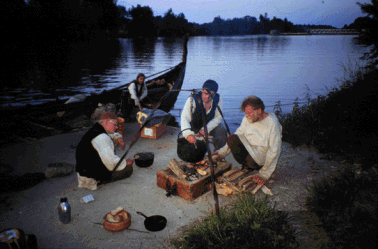 We brewed a barrel of beer and then went on our sailing along the river Yonne. Through Canal de Bourgogne and the rivers of Saone and Rhone, we reached the Mediterranean after two weeks. During these two weeks it was raining every day. There is no cabin in a Viking ship, and to be soaking wet during two weeks implies a special sense of humor among the crew. However, the use of inland waterways makes a relative pleasant camp life possible.
We brewed a barrel of beer and then went on our sailing along the river Yonne. Through Canal de Bourgogne and the rivers of Saone and Rhone, we reached the Mediterranean after two weeks. During these two weeks it was raining every day. There is no cabin in a Viking ship, and to be soaking wet during two weeks implies a special sense of humor among the crew. However, the use of inland waterways makes a relative pleasant camp life possible.
Our travel through France measured 1300 km and 237 locks.
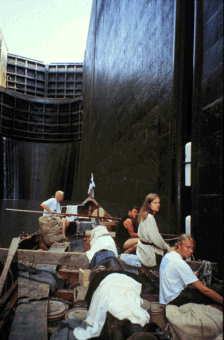 Going through canals and locks with a viking ship, which has a relative fragile construction and which is difficult to manaeuvre in narrow waters among huge barges, was however not always a pleasant experience. In Paris we had to supply the ship with a small outboard engine.
Going through canals and locks with a viking ship, which has a relative fragile construction and which is difficult to manaeuvre in narrow waters among huge barges, was however not always a pleasant experience. In Paris we had to supply the ship with a small outboard engine.
Although the impetuosity of Rhone nowadays is controlled by canals and locks, there is still a rather strong current in some places. It is mysterious how a Viking fleet under Hastein and Bjorn Ironsides with seagoing ships, in the middle of the 9th century, could go up the river Rhone and ravage Valence. In opposite to the Atlantic there is no tidal water, to take help from, when going up a river from the Mediterranean.
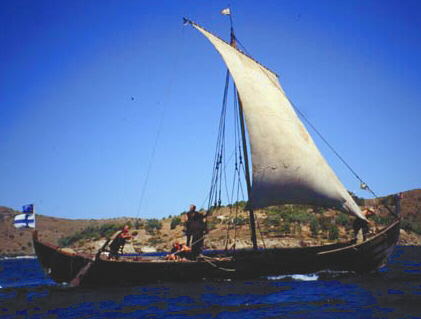 In Cavalaire, on the French southcoast, we had to wait 3 days for the strong northeast wind, the Mistral, to abate. There is no wind-gauge on board but when we were eating, the porridge blew away from the spoon before we got it in our mouths. This gives you an idea about the force of the wind. When the Mistral had abated, but still was blowing strongly, we sailed at full speed to the island of Elba in Italy. The heavy sea caused a lack of appetite among some crewmembers. This influenced the food expenses positively.
In Cavalaire, on the French southcoast, we had to wait 3 days for the strong northeast wind, the Mistral, to abate. There is no wind-gauge on board but when we were eating, the porridge blew away from the spoon before we got it in our mouths. This gives you an idea about the force of the wind. When the Mistral had abated, but still was blowing strongly, we sailed at full speed to the island of Elba in Italy. The heavy sea caused a lack of appetite among some crewmembers. This influenced the food expenses positively.
The more south we came along the Italian westcoast the more the heat and the calm tormented us. The temperament of the harbour-masters also became more unpredictable and it was not always easy to get a mooring place. Some crew members had the honour of being subject to skillful pickpockets when visiting tourist places.
When the temperature comes near 40 degrees Celsius and there is no shadow and no wind, then you understand why the Vikings used slaves and not volunteers for rowing.
Off the southwest coast of Italy long surface nets are laid out for swordfish. These nets are laid out for the night and usually they are unlit. One night we sailed on such a net, but our ship glided almost imperceptibly over it. For a modern sailing yacht such a net can be a nightmare.
We often sailed during the night. A clear starry night on sea is a magnificent experience and makes navigating by stars possible. The oldest lighthouse in the world, the active volcano of Stromboli guided us towards the Strait of Messina. In this strait, which is the only place in the Mediterranean with significant tidal currents, we had fortune on our side and we slipped with the current through the strait. The whirlpools of the narrow strait have in ancient times struck terror in the hearts of sailors. This time we did not see Scylla of Odyssey, who plucked sailors from passing ships.
We now sailed in areas that were ruled by Normans during the 11th and 12th centuries. Here the Vikings that had sailed westwards, the Normans, encountered the Vikings that had sailed eastwards along the Russians rivers, the Byzantine Varangians.
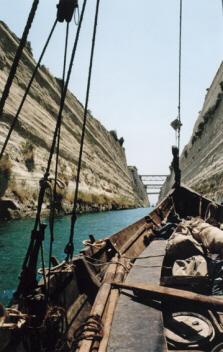 We crossed the Ionian Sea in three and a half days and on the 29th of June we arrived to Lixuri on the island of Cephalonia in Greece. The Normans ruled this island for a short period in the 12th century. In Lixuri we had the opportunity to enjoy the famous Greek hospitality for some days. A strong westerly wind brought us further to Corinth and the remarkable Canal of Corinth. After the passage of the canal we pitched our camp on the island of Aegina.
We crossed the Ionian Sea in three and a half days and on the 29th of June we arrived to Lixuri on the island of Cephalonia in Greece. The Normans ruled this island for a short period in the 12th century. In Lixuri we had the opportunity to enjoy the famous Greek hospitality for some days. A strong westerly wind brought us further to Corinth and the remarkable Canal of Corinth. After the passage of the canal we pitched our camp on the island of Aegina. 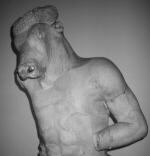 From there we visited Athen, with the ferry, to see the remnants of the civilization of ancient times.
From there we visited Athen, with the ferry, to see the remnants of the civilization of ancient times.
-They say that from the sculptures you can see the ideal of the people who laid the foundation of the Western civilization?
On the Aegian Sea there can be unexpected and rapid changes in direction and speed of the wind. This is stressful for the crew on a Viking ship, which is more dependent on the weather and wind than other vessels are. When we sailed from Syros the wind changed in 10 minutes from a light south breeze to a north gale without any clouds appearing on the sky. We were exposed to Meltemi, the strong north wind which blows in the Aegian Sea during the summer. With maximally reefed sails and one man continuously at the pump we found our way, after 28 hours of hard sailing, to a sheltered inlet on the southwest coast of Leros.
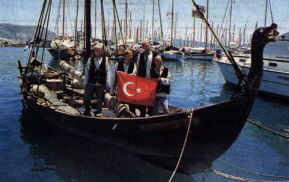 After a two days rest we sailed to Bodrum in Turkey, our end destination this summer. We were kindly received in Bodrum. The director of the town, Tugrul Acar, arranged a winter place for Heimløsa Rus. The ship was taken ashore on the 15th of July. The distance covered this summer was about 2000 nautical miles.
After a two days rest we sailed to Bodrum in Turkey, our end destination this summer. We were kindly received in Bodrum. The director of the town, Tugrul Acar, arranged a winter place for Heimløsa Rus. The ship was taken ashore on the 15th of July. The distance covered this summer was about 2000 nautical miles.
Since we left French inland we had no rain. The Mediterranean area had an exceptionally dry and hot summer. The Scandinavian crew members suffered more from the heat than the South European crew members.
The composition of the international crew changed during those two months the voyage lasted. Only captain Fredrik Koivusalo and our cook Henrik Kahanpää, both from Finland, were on board the whole voyage.
It was an experience to sleep in a bed for the first time in two months.
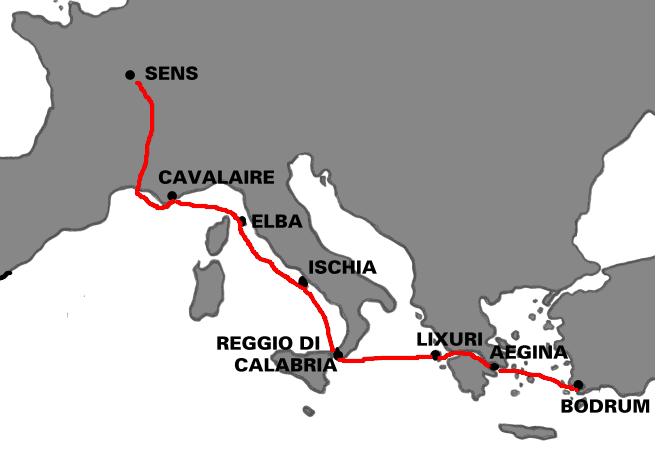 The following persons were crew members on various stages of the journey in 1998:
The following persons were crew members on various stages of the journey in 1998:
| Berg Matthias | Germany |
| Grote Torben | Germany |
| Hansen Mikko | Finland |
| Kahanpää Lauri | Finland |
| Kahanpää Henrik | Finland |
| Kallio Reijo | Finland |
| Koivusalo Fredrik | Finland (captain) |
| Matarese Pietro | Italy |
| Menard Francis | France |
| Samson Jean Francois | France |
| Siponen Pertti | Finland |
| Tenetz Antti | Finland |
| van Elst Jan | Netherlands |
You have Reijo Kallio´s report from the voyage, including positions and some of his pictures, on the map.
| Heimløsa Rus | Voyages in 1996-97 | Voyage in 1999 | Joining the crew | Literary production | Latest news | Main page |